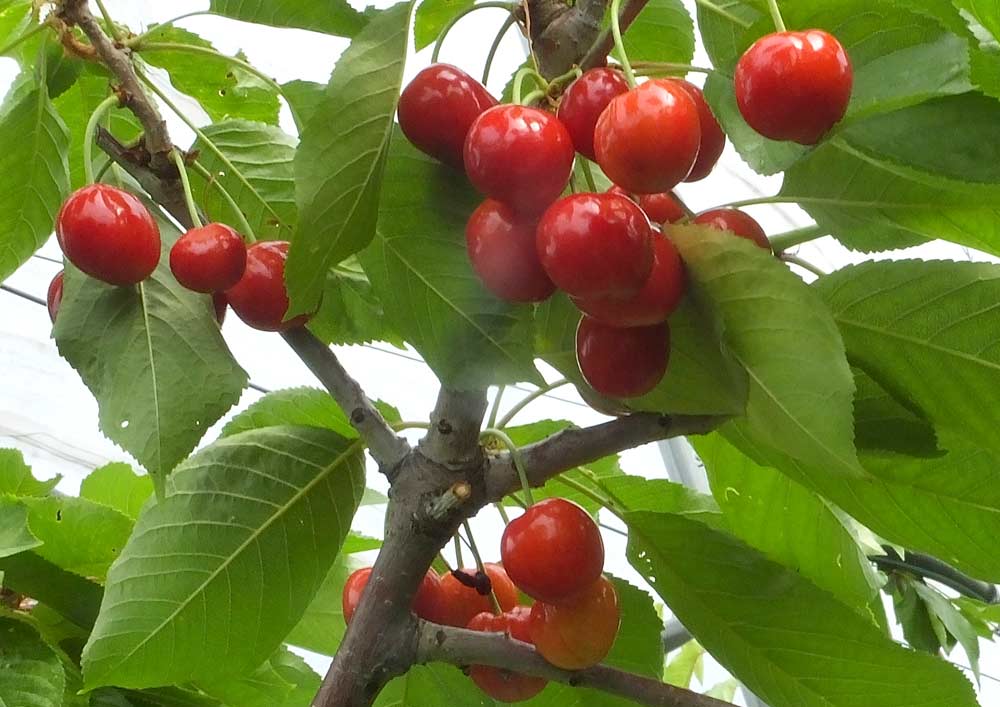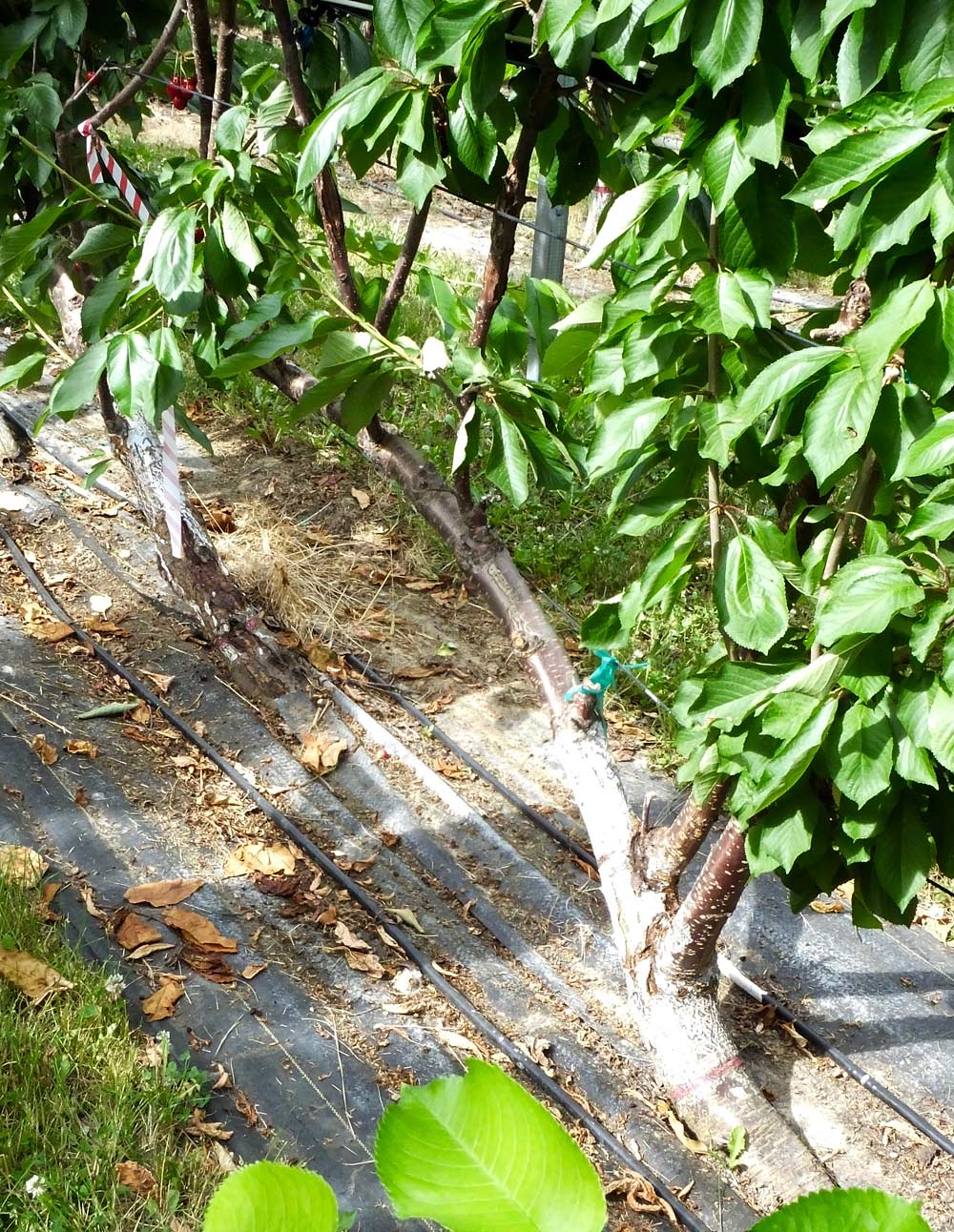An extensive cherry trial of four high-density canopy architectures has led Michigan cherry expert Gregory Lang to change his recommendations for Michigan growers putting in new acreage.
As of a few months ago, he began encouraging growers to try a radical fruiting-wall architecture known as upright fruiting offshoots, or UFO.
Not only that, he now believes that the future of cherry growing may lie in “the even more crazy idea of not just renewing a few branches per year, but renewing the entire tree every six or seven years.”
A professor of horticulture at Michigan State University, Lang has reams of data collected each season on his trial of what are now 7-year-old Benton trees, which he describes as a variety of moderate productivity.
Conducted at MSU’s Clarksville Research Center in west-central Lower Michigan, the trial includes combinations of trees with the dwarfing rootstock Gisela 3, the semi-dwarfing Gisela 5, or the semi-vigorous Gisela 6 superimposed on four canopy architectures.

Gisela 6 in slender spindle or super slender axe (SSA) architecture, all year-old branches are pruned back to the basal flower buds plus one to three vegetative buds to keep fruit production close to the central leader. While it had high yields in years two through four, production has since declined. (Leslie Mertz/Good Fruit Grower)
The four are:
—UFO, in which the tree is planted at a 45-degree angle and bent horizontal like a grape cordon along the lowest wire of a trellis system. Renewable upright fruiting leaders grow from the “cordon” and form a narrow fruiting wall architecture, which can be hedged pre- or postharvest, depending on rootstock vigor.
—Kym Green Bush (KGB), a renewable bush architecture that involves early heading of the tree to produce 15–20 upright fruiting leaders.
—Tall spindle axe (TSA), a central-leader Christmas tree-like architecture in which all branches are pruned back to the permanent central leader for renewal at some point throughout the life of the tree.
—Slender spindle or super slender axe (SSA) architecture, a more extreme version of TSA in which all year-old branches are pruned back to the basal flower buds plus one to three vegetative buds to keep fruit production close to the central leader.
This is a fruiting-wall architecture with trees planted at 2.5 feet apart, compared to 5 feet apart for the other three architectures. It also can be hedged pre- or postharvest, depending on rootstock vigor.
“One of the underlying principles for all these training systems is to grow high-quality fruitwood and minimize the resources … that are being put into permanent structure,” Lang said. “The idea is to renew that fruiting wood periodically so that we always maintain young fruiting sites for high fruit quality. Growers always ask if these high-density, intensively cropped orchards will be productive as long as more traditional orchards, and the answer is yes, we believe these high-density orchards will last for 25 to 30 years, or more, if the fruiting wood is renewed regularly.”
How they did

Gregory Lang of MSU recommends growers try the UFO architecture, in which trees are trained to develop one or two primary leaders as horizontal “cordons” along the lowest wire of a trellis system. Secondary upright fruiting leaders developed on the cordon form a narrow fruiting wall. This training system has had high yields in years five through seven, requires simple pruning and offers easy harvesting, he contends.(Leslie Mertz/Good Fruit Grower)
Gisela 3 performed best on all four architectures in Lang’s Clarksville trial, which may be due to its rich, loamy soil.
“If we were to run this trial at MSU’s Northwest Michigan Horticulture Research Center or Southwest Michigan Research and Extension Center, which have very sandy soils, Gisela 3 would probably have too small of a root system for the poor water- and nutrient-holding capacities of that soil. There, Gisela 5, 6 or 12 would probably be the better choices,” he said.
Canopy architectures are another story. “With them, I think we’d get the same results anywhere,” he contends. For the four architectures, he found:
—SSA was the most precocious and had the highest yields in years two through four, but yields dropped off considerably in year five and haven’t recovered. “I’m very concerned about the ability of that training system to yield at a high enough level to make it worthwhile,” Lang said.
—KGB had the lowest yields in years two through four, a clear result of the pruning and offshoot production required of that system during the first two years, he said. Yields were strong in years five to seven.
—After moderate yields in years two through four, TSA and UFO both outdistanced SSA in year five. Yields increased in subsequent years, making them the most productive of the four systems in years five through seven.
“Until this past year, when growers would ask what system I recommend they plant, I’d say TSA because it gives you moderate precocity and moderate yields even in the first four years, and higher yields starting in the fifth year. In addition, the growers understand the system and get good quality,” he said. “Now, however, I’m telling them that if they really want to optimize things, UFO is probably the way to go.”
UFO’s benefits
Although UFO requires significant investment early on, it offers clear advantages over TSA, according to Lang.
“Growers consider UFO the most intensive to get started because we want them to plant at a weird angle, rub the buds off, and as the new shoots start to come up, tie them to the wires so they stay oriented upright instead of flopping over,” he said. “It’s a lot of labor in the first two years, but the rest of the time it’s easy-peasy because there’s very little to do, and very few decisions to make.”
The fruiting wall produced by UFO is narrow, which allows for easy harvesting. Overall, that can cut the time needed for both pruning and picking by 20 to 40 percent, he calculates. “You’re going to make more money off of a UFO than a TSA.”
With a slim fruiting wall, row spacing can be tighter, which increases the number of trees per acre.
Not only that, he said, growers can use narrower row covers, which allow improved air exchange, thereby decreasing the possibility of trapped heat that can cause problems with fruit quality. (The Clarksville trials use a Cravo automatic retractable roofing system and a Voen passively vented row cover system.)
“In a coordinated trial with AgCanada researcher Denise Neilsen in British Columbia, UFO on Gisela 3 and Gisela 5 are surpassing all the other training systems, so it’s not just us getting these results,” Lang reports.
That is especially good news to Lang. He wanted to make sure he wasn’t unintentionally biasing his study to favor UFO, which is based on a tree architecture Lang invented and subsequently co-developed as a production system with Matthew Whiting, a former graduate student of Lang’s and now associate scientist, associate professor and extension specialist at Washington State University.
“Far and away, UFO is looking really good, growers around the world are slowly trying it, and those who I’ve talked with are planting it commercially once they get a sense of it,” Lang said. “In fact, a couple of operations have put in UFOs for three or four years in a row and they haven’t gone to any other system because they say that they can see the simplicities, efficiencies and uniformities.”
The Clarksville trial will continue for three more years to provide long-term data. While he admits it’s a bit frustrating having to wait for years for answers to questions about high-density training systems, trials like these are providing much-needed insights so growers can get the highest sustainable yields of excellent cherries at the lowest costs. He adds, “I want to know, and the growers want to know, but it takes time.” •
Note: Financial support for Lang’s Clarksville trial comes from the Michigan Cherry Committee, International Fruit Tree Association, MSU/AgBioRsearch, a USDA-AFRI Small Farms grant award #2012-68006-30188, Project GREEEN, and USDA-NIFA Hatch projects MICL01305 and MICL02002. In-kind support has been provided by Cravo of Brantford, Ontario (automatic retractable roof), Voen (passively vented row cover system), Willow Drive Nursery (tree propagation), Peach Ridge Orchard Supply (pruning equipment), Summit Tree Sales (tree procurement), and Gisela Inc. (waived royalties).
– by Leslie Mertz






Hi
Do sweet cherries like burlat, sammit and kordia support ufo training system